Introduction to web programming for java and c# programmers by @drpicox
- 1. Javascript Introduction to Web Programming by Dr. David Rodenas david-rodenas.com twitter.com/drpicox github.com/drpicox for Java and C# programmers © 2017
- 2. History (I) 2 Self Scheme (apply + '(1 2 3 4 5 6)) ===> 21 (set! f (lambda (n) (+ n 100))) (map f '(1 2 3)) ===> (101 102 103) Mocha
- 6. History (IV) 6 Self Scheme Java Javascript ECMAScript
- 7. Compatibility (I) 7 ECMAScript ECMAScript 1 ECMAScript 2 ECMAScript 3 ECMAScript 4 ECMAScript 5 - default - strict ECMAScript 2015 ECMAScript 2016 ECMAScript 2017 https://github.com/tc39/proposals
- 12. Be Careful let value = getSomeValue(); if (value !== value) { alert('Value is not equal to itself'); } // is there the alert possible? 12
- 13. Javascript
- 14. Javascript Types • Everything is an Object • Number: 1, 2, 5, 5000,-10, 3.14, 1e2, 1e-2, Infinity, NaN • String: 'hello','a','long word' • Boolean: true, false • Array: [1,2,3], ['hi','there'], [3,'times', true] • Date: new Date('December 17, 1995 03:24:00'), Date.now() • RegExp: /ab+c/g, new RegExp('ab+c','g') • Function: function hello() { return world; } • Object: any of above, {}, {hello: 'world'} 14
- 15. Javascript Types • Everything is an Object, but • null • undefined 15
- 16. Number (immutable) • IEEE-754: 1, 2, 5, 5000, -10, 3.14, 1e2, 1e-2, Infinity, NaN, … • Methods: toFixed, toExponential, … • Math: it has all methods and constants that Number should have • Cast to number: • let number = Number(value); • let number = parseInt(value, 10); • let number = +value; 16
- 17. Number (immutable) 17 Test it: (1.)
- 18. String (immutable) • Any UCS-2 chain: 'hello', 'a', 'long word', … • Character is length 1 string • 'e' === 'hello'[1] • Properties/Methods: length, slice, trim, concat, split, indexOf, … • Cast to string: • let string = String(value); • let string = value.toString(); • let string = '' + value; 18
- 19. String (immutable) let single = 'single comma string'; let double = "double comma string"; let template = `template with ${'inter' + "polation"}`; 19
- 20. String (immutable) 20 Test it: (2.)
- 21. Boolean (immutable) • Just true / false • Cast to boolean: • let boolean = Boolean(value) • let boolean = !!value 21
- 22. "Boolean" (immutable) 22 FALSY TRUTHY false true null [] undefined {} "" "false" 0 "0" NaN ...
- 23. Boolean // Ternary expressions cond ? aValue : bValue true ? aValue : bValue null ? aValue : bValue cond && aValue || bValue true && aValue || bValue null && aValue || bValue aValue || bValue 23
- 24. Boolean (immutable) 24 Test it: (3.)
- 25. Array • [1,2,3], [42,'sense',{of: 'life'}], [], … • Properties: length, push/pop, shift/unshift, slice, map/reduce/ every/some, indexOf… • Mixed content: • Allow contents of different type for each element, including other arrays • Dynamic length: • array = ['a','b','c']; array[4] = 'e'; • array[3] === undefined • array.length = 3 25
- 26. Array mutators 26 // As stack let array = ['b','c','d']; array.push('e'); let e = array.pop(); array.unshift('a'); let a = array.shift(); // As queue array.push('e'); let b = array.shift(); array.unshift('a'); let e = array.pop(); // Insert let array = ['a','c','d']; array.splice(1, 0, 'b'); // Remove let array = ['a','x','b','c']; array.splice(1, 1); // Sort let array = ['c','a','b']; array.sort(); // Reverse let array = ['c','b','a']; array.reverse();
- 27. Array non-mutators // As functional array let copy = array.slice(); let numbers = ['a','b',1,2,3,'c'].slice(2,5); let moreNumbers = [1,2,3].concat([4,5]); let odds = numbers.filer(n => n % 2); let doubles = numbers.map(n => n * 2); let sum = numbers.reduce((s,n) => s + n); let allPositives = numbers.every(n => n >= 0); let thereIsATwo = numbers.some(n => n == 2); let firstBig = numbers.find(n => n >= 3); let bigIndex = numbers.findIndex(n => n >= 3); let indexOfTwo = numbers.indexOf(2); // Spread destructuring let copy = [...numbers]; let concat = [...numbers, 4, 5, ...[6, 7, 8]]; let [one,...tail] = numbers; 27
- 29. Objects • Anything but undefined or null: 'hello', 3, {rule: 'world'}, … • Properties: prototype, constructor, … • Static Methods: assign, create, defineProperties, defineProperty, freeze, getOwnPropertyDescriptor, getOwnPropertyNames, getOwnPropertySymbols, getPrototypeOf, is, isExtensible, isFrozen, isSealed, keys, preventExtensions, seal, setPrototypeOf, • Methods: hasOwnProperty, isPrototypeOf, propertyIsEnumerable, toLocaleString, toSource, toString, valueOf, … • Built-in objects: Array, ArrayBuffer, Boolean, DataView, Date, Error, EvalError, Float32Array, Float64Array, Function, Generator, GeneratorFunction, Infinity, Int16Array, Int32Array, Int8Array, InternalError, JSON, Map, Math, NaN, Number, Object, Promise, RangeError, Reflect, RegExp, Set, String, Symbol, SyntaxError, TypeError, TypedArray, URIError, Uint16Array, Uint32Arrray, Uint8Array, Uint8ClampedArray, WeakMap, WeakSet, … 29
- 30. Objects • JSON constructor is the most common one • let car = { color: 'blue' }; • Are string key/any value maps: • Get property: obj.propertyName obj['propertyName'] • Set property: obj.propertyName = newValue obj['propertyName'] = newValue 30
- 31. Object // Object is a Map: // pairs string-value (properties) let object1 = { property: 'anyValue', }; let object2 = new Object(); object.property = 'anyValue'; let object3 = new Object(); object['prop' + 'erty'] = 'anyValue'; 31
- 32. Object // By default, you can set any property object.property = 'anyValue'; // And you can get any value let value = object.property; console.assert(value === 'anyValue'); // even if not defined let notDefined = object.notDefined; console.assert(notDefined === undefined); 32
- 33. Be Careful let car = { color: 'blue' }; let carOwners = {}; carOwners[car] = 'elon'; JSON.stringify(carOwners); // hint: car is not string 33
- 34. Objects // Spread & destructuring (in standardisation) let main = {peter: 'tyrion', lena: 'cersei'}; let others = {sean: 'eddard', jason: 'khal'}; let copy = {...main}; let addFields = {...main, emilia: 'daenerys'}; let composed = {...main, ...others}; let {peter, lena} = main; let {peter, ...rest} = main; // Computed keys let main = {['peter']: 'tyrion'}; // shorthand property names let peter = 'tyrion'; let main = { peter }; 34
- 36. Functions • Are Objects • Like arrays, numbers, strings, ... • You can assign to a variable, object property, passed as an argument, returned as result... • Do not use new Function('n', 'n * 2') 36
- 37. Functions // Short notation const incr = a => a + 1; const incr = (a) => a + 1; const incr = a => { return a + 1; }; const incr = (a) => { return a + 1; }; const sum = (a, b) => a + b; const sum = (a, b) => { return a + b }; 37
- 38. Functions // Short notation in object definition const incrementer = { incr(a) { return a + 1; }, }; incrementer.incr(3); // 4 // Long notation: function definition function incr(a) { return a + 1; } // Long notation: function expression const incr = function(a) { return a + 1; } 38
- 39. Functions // Function arguments can missmatch incr(1) // === incr(1, ignoreOtherArguments) incr() // === incr(undefined) // Variable arguments const sum = (first, ...rest) => first + sum(...rest); sum(1, 2, 3) === sum(...[1, 2, 3]) // Arguments may have default values const add = (a, b = 1) => a + b; add(3) === 4 39
- 40. Functions // May return any kind of object const cast(tony, pepper) => ({ tony, pepper }); // No return or empty return is undefined const makeUndefined() => { return; }; // Be careful: semicolon is optional (ops undefined) const makeThree() => { return 1 + 1 + 1; }; 40
- 41. Functions // High order functions const reduce = (array, fn, zero) => { if (array.length === 0) { return zero; } return fn( array[0], reduce(array.slice(1), fn, zero), ); }; const add = (a, b) => a + b; const sum = (array) => reduce(array, add, 0); 41
- 43. Class • Are new in ES2015 • They can be transpiled to any browser that supports Object.create and Object.defineProperties • It uses a notation similar to object short hand • There are no private fields (yet) 43
- 44. Class // have one single constructor class Rectangle { constructor(height, width) { this.height = height; this.width = width; } } // new instances with new const square = new Rectangle(5, 5); // access to set/get like any object square.width = square.width + 1; square['height'] = square['height'] + 1; 44
- 45. Class // have functions (no methods) class Animal { speak() { return 'makes noise'; } } // has not method overloading class Animal { speak() { return 'makes noise'; } speak(predatorNear) { // avoid duplicates return predatorNear ? 'is silent' : 'makes noise'; } } 45
- 46. Class // may have "methods" class Rectangle { constructor(height, width) { this.height = height; this.width = width; } } // new instances with new const square = new Rectangle(5, 5); // access to set/get like any object square.width = square.width + 1; square['height'] = square['height'] + 1; 46
- 47. Class (this) // use «this» to access private members class Pet { constructor(name) { this.name; } getName() { return this.name; } salute() { return `Hi ${this.getName()}`; } speak() { return 'makes noise'; } } 47
- 48. Class (this) // there is no method const boby = new Pet('boby'); // only functions const speak = boby.speak; speak(); const getName = boby.getName; getName(); const lucas = { name: 'lucas', getName }; lucas.getName(); 48 METHOD giphy.com
- 49. Class // use extends for inheritance class Animal { speak() { return 'makes noise'; } } // add behaviour class Cat extends Animal { purr() { … } } // or redefine behaviour class Lion extends Cat { speak() { return 'roars'; } } 49
- 51. Closures • Functions inside functions can access to variables and arguments of outer functions. • Variables and arguments keep their existence after the outer function is finished. 51
- 52. Closures const makeMultiply = (times) => { return (value) => times * value; }; const triple = makeMultiply(3); triple(3) // === 9 52
- 53. Closures const makeCounter = (initial) => { return () => { const current = initial; initial += 1; return current; }; }; const countGuests = makeCounter(1); const countActors = makeCounter(1); // countActors() ? countActors() ? // countGuests() ? countActors() ? countGuests() ? 53
- 54. Closures // The equivalent in old Java public IntSupplier makeCounter(int initial) { final AtomicInteger counter = new AtomicInteger(initial); return new IntSupplier() { public int getAsInt() { return counter.getAndIncrement(); } }; } 54
- 55. Closures 55 Function Call 4 Return @address Stack Function Call 3 Return @address Function Call 2 Return @address Function Call 1 Return @address Current Stack Frame Grow Local Variables Local Variables Local Variables Local Variables
- 56. Closures 56 Function Call 4 Return @address Stack Function Call 3 Return @address Function Call 2 Return @address Function Call 1 Return @address Local Variables Local Variables Local Variables Local Variables Scopes Global Scope Parent Scope new new new new
- 57. Closures // Use as callbacks const startClock = () => { let count = 0; let intervalId = setInterval(() => { console.log(count += 1); }, 1000); return () => { clearInterval(intervalId); }; }; let stopClock = startClock(); // …wait few seconds… stopClock(); 57
- 58. Closures // Use to create modules let myObj = (() => { let privateState = …; const privateFunction = () => { … } return { publicMethodA: function() { …do something with privateState… }, publicMethodB: function() { …do something with privateFunction… }, … }; }()); 58
- 60. Async/Await • Javascript is asynchronous in its foundation. • Traditionally it uses callbacks to handle asynchronicity: you pass a function which is called when the operation is finished with the resulting data as argument. • ES2015 standarises: a kind of object for dependency inversion, it allows you to call an operation before knowing which function (or functions) handles the resulting data. • ES2017 introduces async/await: promises were introduced in the core, and functions can natively generate them and consume them emulating a synchronized methods (but they are not blocking and may be interleaved with other callbacks) 60
- 61. Async/Await • There is only one thread • no interferences • no semaphores • no deadlocks • no quantum loss • but also: • no parallel processing • no preemption (a callback may freeze the whole system) 61
- 62. Async/Await // Event loop while (true) { const events = waitForEvents(); events.forEach(event => { const callbacks = getEventCallbacks(event); callbacks.forEach(callback => { try { callback(event); } catch (e) { … } }); }); } 62
- 63. Async/Await // Traditional callback setTimeout(() => { console.log('5 seconds passed'); }, 5000); const cb = () => console.log('5 seconds passed'); setTimeout(cb, 5000); 63
- 64. Async/Await // Traditional callback const button = document.getElementById('my-button'); button.addEventListener('click', (event) => { console.log('my-button-clicked', event); }); const req = new XMLHttpRequest(); req.onreadystatechange = () => { if (req.readyState === 4 && req.status !== 200) { console.log('loaded', req.responseText); } } req.open("GET", "/api/fruits"); req.send(null); 64
- 65. Async/Await // Traditional callback const get = (url, cb) => { const req = new XMLHttpRequest(); req.onreadystatechange = () => { if (req.readyState === 4 && req.status !== 200) { cb(req.responseText); } } req.open("GET", url); req.send(null); }; get('/api/fruits', (response) => { console.log('loaded', response); }); 65
- 66. Async/Await // With Promises const responsePromise = fetch('/api/fruits'); responsePromise.then((response) => { console.log('loaded', response); }); 66
- 67. Async/Await // Promises and chaining const responsePromise = fetch('/api/fruits'); responsePromise.then((response) => { console.log('loaded', response); }); const bananaPromise = responsePromise.then(response => { return response.fruits.banana; }); bananaPromise.then((banana) => { minion.eat(banana); }); 67
- 68. Async/Await // Promises creation const delay = (ms) => { return new Promise((resolve, reject) => { setTimeout(resolve, ms); }); }; delay(5000).then(() => { console.log('5 seconds passed'); }); 68
- 69. Async/Await // Promises creation const failAfter = (ms) => { return new Promise((resolve, reject) => { setTimeout(reject, ms); }); }; failAfter(5000).then(() => { console.log('5 seconds passed'); }, () => { console.log('it has failed'); }); 69
- 70. Async/Await // Async functions const sayHelloDelayed = async (ms) => { await delay(ms); console.log('hello'); }; sayHelloDelayed(5000); 70
- 71. Async/Await // Async functions const sayHelloDelayed = async (ms) => { await delay(ms); console.log('hello'); }; console.log('this message prints before "hello"'); sayHelloDelayed(5000); 71
- 72. Async/Await // Async functions const sayHelloDelayed = async (ms) => { await delay(ms); console.log('hello'); }; console.log('this prints before "hello"'); sayHelloDelayed(5000); console.log('this also prints before "hello"'); 72
- 73. Async/Await // Async functions const sayHelloDelayed = async (ms) => { await delay(ms); console.log('hello'); }; console.log('this prints before "hello"'); const resultPromise = sayHelloDelayed(5000); console.log('this also prints before "hello"'); 73
- 74. Async/Await // Async functions const sayHelloDelayed = async (ms) => { await delay(ms); console.log('hello'); }; console.log('this prints before "hello"'); const resultPromise = sayHelloDelayed(5000); console.log('this also prints before "hello"'); resultPromise.then(() => { console.log('this prints after "hello"'); }); 74
- 75. Async/Await // Async functions const sayHelloDelayed = async (ms) => { await delay(ms); console.log('hello'); }; (async () => { console.log('this prints before "hello"'); const resultPromise = sayHelloDelayed(5000); console.log('this also prints before "hello"'); resultPromise.then(() => { console.log('this prints after "hello"'); }); })(); 75
- 76. Async/Await // Async functions const sayHelloDelayed = async (ms) => { await delay(ms); console.log('hello'); }; (async () => { console.log('this prints before "hello"'); const resultPromise = sayHelloDelayed(5000); console.log('this also prints before "hello"'); await resultPromise; console.log('this prints after "hello"'); })(); 76
- 77. Async/Await // Async functions const sayHelloDelayed = async (ms) => { await delay(ms); console.log('hello'); }; (async () => { console.log('this prints before "hello"'); await sayHelloDelayed(5000); console.log('this prints after "hello"'); })(); 77
- 78. Async/Await // Async functions (async () => { try { await failDelayed(5000); } catch (e) { console.log('failed after 5 seconds'); } })(); 78
- 80. Import/Export • Allows to link with other files and get and publish symbols • Symbols can be named or default • Two path import possibilities: • paths beginning with package-name import from package • relative paths (a.k.a. './…') import from file in the current directory • It has fallbacks: • it automatically appends .js .jsx or .json if not specified • if destination is a folder it reads index.js[x] 80
- 81. Import/Export import rule from "./rule"; import * as math from "math-tools"; import { sqrt } from "math-tools"; import { sqrt as sq } from "math-tools"; import { min, max } from "math-tools"; import { min, max as big, … } from "math-tools"; import defaultMember, { sqrt } from "math-tools"; import defaultMember, * as math from "math-tools"; import "math-tools"; 81
- 82. Import/Export export { sqrt, min, max }; export { squareRoot as sqrt, min, max }; export let sqrt, min, max; export let min = (a,b) => a < b ? a : b; export const min = (a,b) => a < b ? a : b; export default expression; export default function (…) { … } export default async function (…) { … } export default async class (…) { … } export default function sqrt(…) { … } export { sqrt as default, … }; export * from './other-file'; export { name1, name2, …, nameN } from './other-file'; export { import1 as name1, name2, …, nameN } from …; 82
- 85. Object • Java, C#, C++, … are class oriented • Classes inherits from other Classes • Javascript is instance oriented • Objects (instances) inherits from other objects 85 car: prototype is mcQueen: raceCar: prototype is Car instance of mcQueen: RaceCar inherits from
- 86. Object • Javascript is “classless” but has inheritance • Java, C# is class oriented • Javascript is instance oriented • Inheritance is performed through prototype • Every object can become a prototype of other object • Every object has another object as prototype • The main prototype of almost all objects is Object.prototype 86
- 87. Object // By default objects have a Object's prototype let car1 = { color: 'blue', }; let car2 = Object.create(Object.prototype); car.color = 'blue'; 87 carX: .color Object.prototype:prototype is
- 88. Object // Object.prototype { constructor: …, hasOwnProperty: …, toString: …, … } 88
- 89. Object // But it can have no prototype let prototypelessObject = Object.create(null); // Object.getPrototypeOf(prototypelessObject) ? // Object.getPrototypeOf(Object.prototype) ? // Object.getPrototypeOf(Object) ? 89 prototypelessObject: nullprototype is
- 90. Object // Objects can have any object as prototype let car = { color: 'blue', }; let tesla = Object.create(car); // car.color ? // tesla.color ? 90 car: .color Object.prototype:tesla: prototype is has value fallback prototype is has value fallback
- 91. Object // Objects inherits its prototype properties let car = { color: 'blue', }; let tesla = Object.create(car); tesla.brand = 'tesla'; // tesla.color ? // tesla.brand ? // Object.keys(tesla) ? 91 car: .color tesla: .brand
- 92. Object // Objects can overwrite prototype properties let car = { color: 'blue', }; let ferrari = Object.create(car); ferrari.color = 'red'; // car.color ? // ferrari.color ? 92 car: .color ferrari: .color
- 93. Be Careful let car = { color: 'red' }; let parkingSpot = { car: car, }; let wolowitzParkingSpot = Object.create(parkingSpot); wolowitzParkingSpot.car.color = 'gray'; // wolowitzParkingSpot.car.color ? // car.color ? 93 car: .color parkingSpot: .car
- 94. Object class Object { private Map<String,Object> properties; private Object prototype; public Object get(String key) { if (properties.containsKey(key)) { return properties.get(key); } else if (prototype != null) { return prototype.get(key); } else { return Undefined; } } public void set(String key, Object value) { properties.put(key, value); } } 94
- 95. Object • In matter of speaking: • Object.method.property are like Java/C# static members ex: Object.create • Object.prototype.property are like Java/C# instance members ex: Object.prototype.isPrototypeOf • Only properties, in matter of speaking: • methods are properties whose value is a function • members are properties whose value is not a function • Object is a map, with an optional fallback map called prototype 95
- 96. Be Careful let wordCount = {}; let word; while (word = getSomeWord()) { if (wordCount[word]) { wordCount[word] ++; } else { wordCount[word] = 1; } } // does it works? always? 96
- 97. «Self» Classes
- 100. Class Object.getPrototypeOf(Function) === Function.prototype typeof Function === 'function' 100
- 101. Class Object.getPrototypeOf(Function) === Function.prototype Object.getPrototypeOf(Object) ? typeof Function === 'function' typeof Function ? 101
- 102. Class Object.getPrototypeOf(Function) === Function.prototype Object.getPrototypeOf(Object) === Function.prototype Object.getPrototypeOf(Number) === Function.prototype typeof Function === 'function' typeof Object === 'function' typeof Number === 'function' 102
- 103. Class Object.getPrototypeOf(Function) === Function.prototype Object.getPrototypeOf(Object) === Function.prototype Object.getPrototypeOf(Number) === Function.prototype typeof Function === 'function' typeof Object === 'function' typeof Number === 'function' … // Functions are constructors! new Number(3) 103
- 104. Class function Animal() { } let animal = new Animal(); 104 Animal.prototype:animal:
- 105. Class function Animal(name) { this.name = name; } let fievel = new Animal('fievel'); 105 Animal.prototype: fievel: .name
- 106. Class function Animal(name) { this.name = name; } Animal.prototype.speak = function() { console.log(this.name + ' makes a noise'); }; let fievel = new Animal('fievel'); 106 Animal.prototype: .speak fievel: .name
- 107. Class function Animal(name) { this.name = name; } Animal.prototype.speak = function() { console.log(this.name + ' makes a noise'); }; let fievel = new Animal('fievel'); let tanya = new Animal('tanya'); 107 Animal.prototype: .speak tanya: .name fievel: .name
- 108. Class function Animal(name) { this.name = name; } Animal.prototype.speak = function() { console.log(this.name + ' makes a noise'); }; let fievel1 = new Animal('fievel'); let fievel2 = Object.create(Animal.prototype); Animal.call(fievel2, 'fievel'); 108
- 109. Class function Animal(name) { this.name = name; } Animal.prototype.speak = function() { … }; function Lion(name) { Animal.call(this, name + ' the lion'); } Lion.prototype = Object.create(Animal.prototype); Lion.prototype.constructor = Lion; Lion.prototype.speak = function() { console.log(this.name + ' roars!'); }; 109 Animal.prototype: .speak .constructor Lion.prototype: .speak .constructor
- 110. Class class Animal { constructor(name) { this.name = name; } speak() { console.log(this.name + ' makes a noise'); } } class Lion extends Animal { constructor(name) { super(name + ' the lion'); } speak() { console.log(this.name + ' roars'); } } 110
- 111. Class function Animal(name) { this.name = name; } Animal.prototype.speak = function() { console.log(this.name + ' makes a noise'); } class Lion extends Animal { constructor(name) { super(name + ' the lion'); } speak() { console.log(this.name + ' roars'); } } 111
- 112. Everything is an Object
- 113. Everything is an object const array = [1,2,3]; array.foo = 'bar'; const add = (a, b) => a + b; add.foo = 'bar'; 113





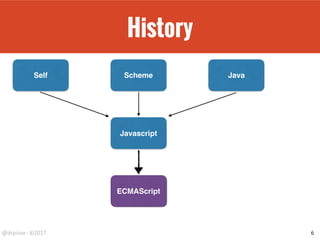


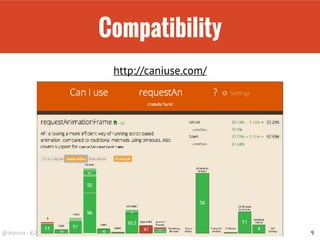




![Javascript Types
• Everything is an Object
• Number: 1, 2, 5, 5000,-10, 3.14, 1e2, 1e-2, Infinity, NaN
• String: 'hello','a','long word'
• Boolean: true, false
• Array: [1,2,3], ['hi','there'], [3,'times', true]
• Date: new Date('December 17, 1995 03:24:00'), Date.now()
• RegExp: /ab+c/g, new RegExp('ab+c','g')
• Function: function hello() { return world; }
• Object: any of above, {}, {hello: 'world'}
14](https://image.slidesharecdn.com/introductiontowebprogrammingforjavaandcprogrammersbydrpicox-170324090732/85/Introduction-to-web-programming-for-java-and-c-programmers-by-drpicox-14-320.jpg)



![String (immutable)
• Any UCS-2 chain: 'hello', 'a', 'long word', …
• Character is length 1 string
• 'e' === 'hello'[1]
• Properties/Methods: length, slice, trim, concat, split, indexOf,
…
• Cast to string:
• let string = String(value);
• let string = value.toString();
• let string = '' + value;
18](https://image.slidesharecdn.com/introductiontowebprogrammingforjavaandcprogrammersbydrpicox-170324090732/85/Introduction-to-web-programming-for-java-and-c-programmers-by-drpicox-18-320.jpg)



!["Boolean" (immutable)
22
FALSY TRUTHY
false true
null []
undefined {}
"" "false"
0 "0"
NaN ...](https://image.slidesharecdn.com/introductiontowebprogrammingforjavaandcprogrammersbydrpicox-170324090732/85/Introduction-to-web-programming-for-java-and-c-programmers-by-drpicox-22-320.jpg)


![Array
• [1,2,3], [42,'sense',{of: 'life'}], [], …
• Properties: length, push/pop, shift/unshift, slice, map/reduce/
every/some, indexOf…
• Mixed content:
• Allow contents of different type for each element, including other
arrays
• Dynamic length:
• array = ['a','b','c']; array[4] = 'e';
• array[3] === undefined
• array.length = 3
25](https://image.slidesharecdn.com/introductiontowebprogrammingforjavaandcprogrammersbydrpicox-170324090732/85/Introduction-to-web-programming-for-java-and-c-programmers-by-drpicox-25-320.jpg)
![Array mutators
26
// As stack
let array = ['b','c','d'];
array.push('e');
let e = array.pop();
array.unshift('a');
let a = array.shift();
// As queue
array.push('e');
let b = array.shift();
array.unshift('a');
let e = array.pop();
// Insert
let array = ['a','c','d'];
array.splice(1, 0, 'b');
// Remove
let array = ['a','x','b','c'];
array.splice(1, 1);
// Sort
let array = ['c','a','b'];
array.sort();
// Reverse
let array = ['c','b','a'];
array.reverse();](https://image.slidesharecdn.com/introductiontowebprogrammingforjavaandcprogrammersbydrpicox-170324090732/85/Introduction-to-web-programming-for-java-and-c-programmers-by-drpicox-26-320.jpg)
![Array non-mutators
// As functional array
let copy = array.slice();
let numbers = ['a','b',1,2,3,'c'].slice(2,5);
let moreNumbers = [1,2,3].concat([4,5]);
let odds = numbers.filer(n => n % 2);
let doubles = numbers.map(n => n * 2);
let sum = numbers.reduce((s,n) => s + n);
let allPositives = numbers.every(n => n >= 0);
let thereIsATwo = numbers.some(n => n == 2);
let firstBig = numbers.find(n => n >= 3);
let bigIndex = numbers.findIndex(n => n >= 3);
let indexOfTwo = numbers.indexOf(2);
// Spread destructuring
let copy = [...numbers];
let concat = [...numbers, 4, 5, ...[6, 7, 8]];
let [one,...tail] = numbers;
27](https://image.slidesharecdn.com/introductiontowebprogrammingforjavaandcprogrammersbydrpicox-170324090732/85/Introduction-to-web-programming-for-java-and-c-programmers-by-drpicox-27-320.jpg)


![Objects
• JSON constructor is the most common one
• let car = { color: 'blue' };
• Are string key/any value maps:
• Get property:
obj.propertyName
obj['propertyName']
• Set property:
obj.propertyName = newValue
obj['propertyName'] = newValue
30](https://image.slidesharecdn.com/introductiontowebprogrammingforjavaandcprogrammersbydrpicox-170324090732/85/Introduction-to-web-programming-for-java-and-c-programmers-by-drpicox-30-320.jpg)
![Object
// Object is a Map:
// pairs string-value (properties)
let object1 = {
property: 'anyValue',
};
let object2 = new Object();
object.property = 'anyValue';
let object3 = new Object();
object['prop' + 'erty'] = 'anyValue';
31](https://image.slidesharecdn.com/introductiontowebprogrammingforjavaandcprogrammersbydrpicox-170324090732/85/Introduction-to-web-programming-for-java-and-c-programmers-by-drpicox-31-320.jpg)

![Be Careful
let car = {
color: 'blue'
};
let carOwners = {};
carOwners[car] = 'elon';
JSON.stringify(carOwners); // hint: car is not string
33](https://image.slidesharecdn.com/introductiontowebprogrammingforjavaandcprogrammersbydrpicox-170324090732/85/Introduction-to-web-programming-for-java-and-c-programmers-by-drpicox-33-320.jpg)
![Objects
// Spread & destructuring (in standardisation)
let main = {peter: 'tyrion', lena: 'cersei'};
let others = {sean: 'eddard', jason: 'khal'};
let copy = {...main};
let addFields = {...main, emilia: 'daenerys'};
let composed = {...main, ...others};
let {peter, lena} = main;
let {peter, ...rest} = main;
// Computed keys
let main = {['peter']: 'tyrion'};
// shorthand property names
let peter = 'tyrion';
let main = { peter };
34](https://image.slidesharecdn.com/introductiontowebprogrammingforjavaandcprogrammersbydrpicox-170324090732/85/Introduction-to-web-programming-for-java-and-c-programmers-by-drpicox-34-320.jpg)



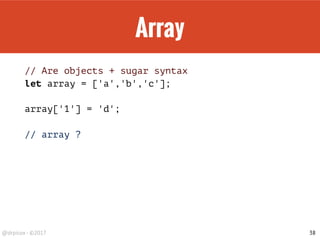
![Functions
// Function arguments can missmatch
incr(1) // === incr(1, ignoreOtherArguments)
incr() // === incr(undefined)
// Variable arguments
const sum = (first, ...rest) => first + sum(...rest);
sum(1, 2, 3) === sum(...[1, 2, 3])
// Arguments may have default values
const add = (a, b = 1) => a + b;
add(3) === 4
39](https://image.slidesharecdn.com/introductiontowebprogrammingforjavaandcprogrammersbydrpicox-170324090732/85/Introduction-to-web-programming-for-java-and-c-programmers-by-drpicox-39-320.jpg)

![Functions
// High order functions
const reduce = (array, fn, zero) => {
if (array.length === 0) { return zero; }
return fn(
array[0],
reduce(array.slice(1), fn, zero),
);
};
const add = (a, b) => a + b;
const sum = (array) => reduce(array, add, 0);
41](https://image.slidesharecdn.com/introductiontowebprogrammingforjavaandcprogrammersbydrpicox-170324090732/85/Introduction-to-web-programming-for-java-and-c-programmers-by-drpicox-41-320.jpg)


![Class
// have one single constructor
class Rectangle {
constructor(height, width) {
this.height = height;
this.width = width;
}
}
// new instances with new
const square = new Rectangle(5, 5);
// access to set/get like any object
square.width = square.width + 1;
square['height'] = square['height'] + 1;
44](https://image.slidesharecdn.com/introductiontowebprogrammingforjavaandcprogrammersbydrpicox-170324090732/85/Introduction-to-web-programming-for-java-and-c-programmers-by-drpicox-44-320.jpg)

![Class
// may have "methods"
class Rectangle {
constructor(height, width) {
this.height = height;
this.width = width;
}
}
// new instances with new
const square = new Rectangle(5, 5);
// access to set/get like any object
square.width = square.width + 1;
square['height'] = square['height'] + 1;
46](https://image.slidesharecdn.com/introductiontowebprogrammingforjavaandcprogrammersbydrpicox-170324090732/85/Introduction-to-web-programming-for-java-and-c-programmers-by-drpicox-46-320.jpg)



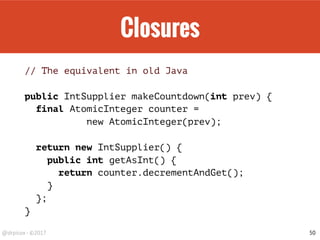





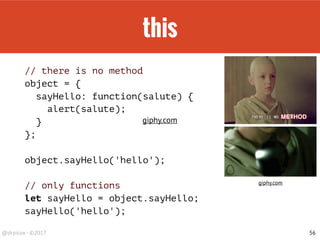


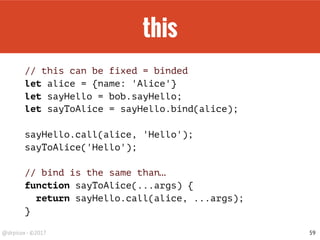



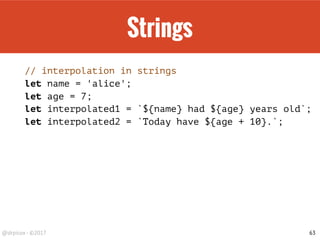





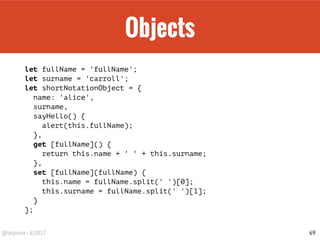






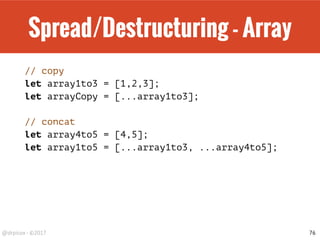



![Import/Export
• Allows to link with other files and get and publish symbols
• Symbols can be named or default
• Two path import possibilities:
• paths beginning with package-name import from package
• relative paths (a.k.a. './…') import from file in the current directory
• It has fallbacks:
• it automatically appends .js .jsx or .json if not specified
• if destination is a folder it reads index.js[x]
80](https://image.slidesharecdn.com/introductiontowebprogrammingforjavaandcprogrammersbydrpicox-170324090732/85/Introduction-to-web-programming-for-java-and-c-programmers-by-drpicox-80-320.jpg)





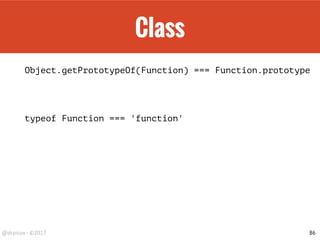

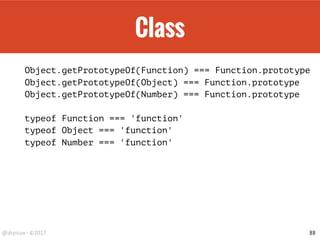







![Be Careful
let wordCount = {};
let word;
while (word = getSomeWord()) {
if (wordCount[word]) {
wordCount[word] ++;
} else {
wordCount[word] = 1;
}
}
// does it works? always?
96](https://image.slidesharecdn.com/introductiontowebprogrammingforjavaandcprogrammersbydrpicox-170324090732/85/Introduction-to-web-programming-for-java-and-c-programmers-by-drpicox-96-320.jpg)




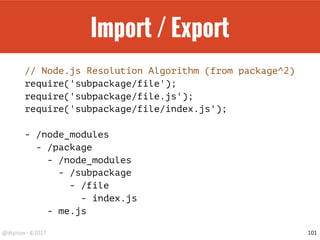










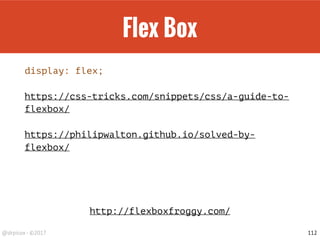
![Everything is an object
const array = [1,2,3];
array.foo = 'bar';
const add = (a, b) => a + b;
add.foo = 'bar';
113](https://image.slidesharecdn.com/introductiontowebprogrammingforjavaandcprogrammersbydrpicox-170324090732/85/Introduction-to-web-programming-for-java-and-c-programmers-by-drpicox-113-320.jpg)







































![창원오피톡 창원오피방 창원오피 오피톡[ optok4] 창원op 창원건마 창원건전마사지](https://cdn.slidesharecdn.com/ss_thumbnails/random-170323080715-thumbnail.jpg?width=560&fit=bounds)



























































